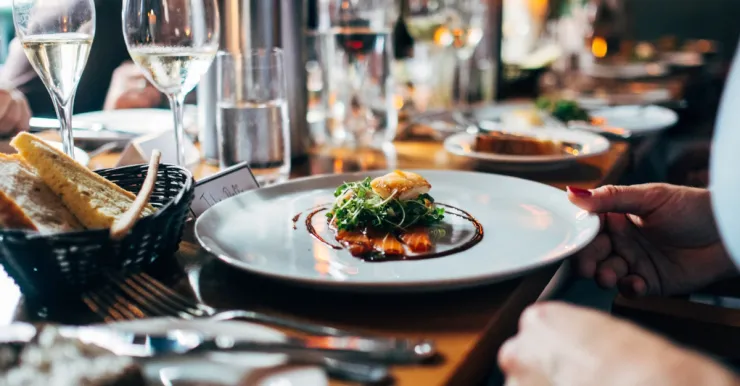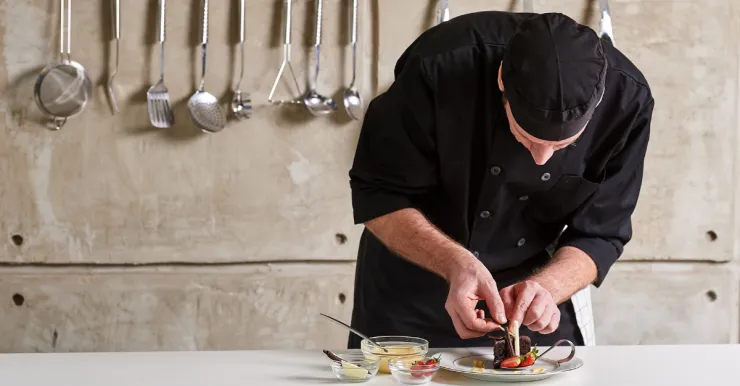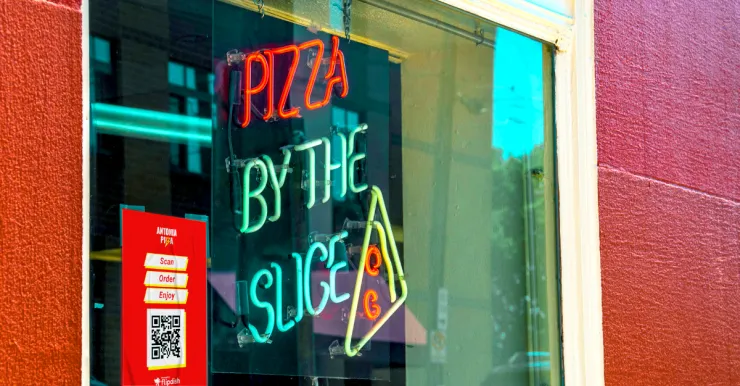What does it take to manage a restaurant? Or to build a food business from scratch and turn it into a local hero - or something more?
Great food of course. But it doesn’t end there. And unless you’re taking the right approach to restaurant management, and learning from the experts, then chances are you’ll be letting that great food down.
Restaurant management is a huge subject, and we can’t pretend to cover everything you will need to know in a document like this. But what we can do is point you in the right direction. At Flipdish we work with thousands of food businesses and restaurants every day. We help them succeed, and we see what works and what doesn’t.
Some of that knowledge is encapsulated here. Whether you are just starting out, or looking to refresh your skills or find new approaches, we hope you find it useful.
One short note: throughout this guide we use the word ‘restaurant’, but most of the advice in here applies to a wide range of food businesses, including those aimed at collection or delivery, dark or ‘ghost’ kitchens, and many more.
What is restaurant management?
To understand restaurant management, it can be helpful to divide the subject into two broad categories as follows:
The strategic decisions and analysis that dictate the long-term approach and management of your restaurant. Think menu planning, food cost management, brand development, cost control etc.
The day-to-day operations, or how you behave in-the-moment with staff, customers, or even just how you manage all the daily processes that go into a smooth-running business.
Of course, there is a huge amount of overlap between these two categories, and most of what we will talk about falls a little in both. But it can still be a useful organising principle.
You’ll notice that independent of a couple of specific issues, most of ‘restaurant management’ could just as easily be referred to as ‘management’. That isn’t a coincidence. The unique nature of food businesses sometimes blinds us to the importance of good management. As opposed to, for example, good food. But we need both to survive and thrive.
So with that in mind, and in no particular order, let’s look at 10 golden rules for restaurant management success.
1. Know what you are trying to do
It sounds obvious, but it is the first and most important rule of restaurant management: have a clear vision of what your business is about, who it is for, and what makes your proposition unique.
Today the restaurant market is more crowded than ever before. In fact for many consumers there is an almost bewildering array of choice when either eating out or ordering for delivery.
At the same time, consumers are more willing to travel to or consider food businesses further from home. We don’t just order from the local takeaway any more, we have a favourite pizza company and don’t mind paying a little more for delivery.
In this environment, you must stand out to survive. Restaurants that do have no limit to their growth. Restaurants that don’t will never go beyond limited local appeal.
In terms of what this actually means, consider some of the following:
Identify restaurants and chains that you admire and ask why. Deconstruct their success, and spot what they do well. In limited circumstances, it’s even OK to directly copy a great idea you’ve seen elsewhere.
Be memorable. Have an unusual signature dish or drink. Invest in decor that your customers won’t forget. If you have a theme, really commit to it throughout.
Don’t attempt to be all things to all people. While it is tempting to pack your menu with every item under the sun, that’s not what makes a restaurant stick in the mind. It’s better to be THE place in town for chicken wings than just another restaurant with the same menu as a dozen others.
Be authentic. When you’re doing something you love, and that you care about, people notice. You can’t fake it, or at least, it’s hard to. So before you do anything read that headline one more time: know what you are trying to do. If it helps, write a ‘food philosophy’ and share it with your staff and customers.

2. Get to know the business
Particularly if you are just starting to consider a future in food, this advice is invaluable. Spend some time working for someone else and learning first-hand what works, and what doesn’t work so well.
Let’s face it, although a guide like this can be a useful reference, it’s never going to be a substitute for getting out there and experiencing the inside of a restaurant business for yourself. But despite this, it’s amazing how many people attempt to launch food businesses without any experience - and often fail.
So if possible, get some direct experience and learn how food businesses work from the inside. Whether high or low, it is amazing what you can learn if you’re consciously looking to. And in many cases you’ll make valuable connections that you can turn to for advice in the future. They may even end up working with you.
3. Focus on customer experience - online and offline
There’s a reason we split restaurants into ‘front of house’ and ‘back of house’ - and stress the equal importance of each. What the customer experiences - the ‘front of house’ - is absolutely vital to your success.
It’s also important to understand that today your front of house extends beyond your physical bricks and mortar premises. It incorporates your brand out in the wider world, your website, your social media presence, your online ordering platform, and even your delivery service.
In fact, let’s take delivery as an example.
The quality of a delivery service can make or break the overall impact of the food and service you provide. In extreme but not unheard of cases, you can invest a lot of effort into creating the perfect dish, only for it to get ‘lost’ in transit. And even if that doesn’t happen, you don’t want your food arriving lukewarm or scraped off the inside of a bag.
So when choosing exactly HOW your food gets to your customer, you need to consider not just cost and convenience, but also how this impacts on the overall customer experience. Perhaps outsourcing this to a global food marketplace relying on casual labour isn’t always the best option.
We’re using delivery as an example here, but of course, this applies to every part of your business and every part of the customer experience. To give one more example: is your website a pleasure to use, whether for booking a table or ordering food for delivery or collection? Consumers come back to experiences they enjoy, but they run a mile from those that are frustrating and time-consuming - no matter how good your food is.
In other words, pay great attention to every aspect of the experience. Optimise it. Test it. Listen to customer feedback. Do your food justice!
4. Build out multiple revenue streams
If there’s one thing the restaurant business learned from Covid-19, it’s that multiple revenue streams are not just vital to long-term survival, but they can also offer up existing new opportunities for expansion and growth.
So when looking at your overall restaurant management picture, investigate every avenue and every channel for revenue.
If you only offer dine-in, consider offering click-and-collect services. This is a fast and easy way to add top-line revenue and avoid being limited by the number of covers in your premises. And as many restaurants discovered over the course of 2020, it can be quick and easy to do.
Another great (and recent) example of the incremental revenue stream is meal kit delivery. Meeting the needs of those who want great quality food at home, and who positively enjoy taking a small part in the process, meal kits are booming business. And they are adding valuable revenue streams for restaurants at both ends - and the middle - of the market.
5. Be inspired by others
We briefly mentioned the possibility of taking ideas, even entire concepts, from elsewhere. So let’s look closer at how smart restaurant managers and owners are always on the look out for smart ways to improve their business, and why you should be too.
It really boils down to two words. Be curious.
Just because you’re in food, don’t stop visiting other restaurants and food businesses as a customer. In fact, make a point of visiting new places. And when you’re there, pay attention. How is the menu structured? Is there an innovative theme? How do the front-of-house staff interact, and what processes are they following? Are there any interesting elements to the fit-out and decor?

These are just a few examples of course. The truth is that in any industry, or indeed almost any human activity, the smart operator is always looking around and asking themselves what they could learn from others, and (let’s be blunt) what great ideas they could steal.
It is foolish to believe we know everything, and wise to always be on the lookout for ways to improve. And in the world of restaurant management, where it is relatively easy (and enjoyable) to get a sense of what makes great places tick, there is no excuse not to.
6. Get your pricing right
We could write a book about costs and pricing in the restaurant industry. Many people have. That’s a demonstration of just how important this topic is. The bottom line is this: if you’re losing money on each dish, you’re losing money full stop. So it is vitally important to control food costs on the one hand, and price appropriately on the other.
As a rule of thumb food costs should be around 30% of the price you’re charging customers, but of course rules are made to be broken, so don’t follow this blindly. And don’t look at pricing only from one angle: first be creative (but realistic) around where you can effectively lower food costs in order to be more competitive on the menu.
Of course it is important to understand the ‘going rate’ for the type of food you serve. But be very careful not to sell yourself short. You need to be realistic about costs and ensure that what you sell is going to pay for itself and the rest of your business, so don’t make the mistake of assuming that price is everything when it comes to consumer choice. Have confidence in your business, and confidence in your pricing.
Lastly, always be on the lookout for higher-margin items like signature drinks or appetizers that can make a real difference to your bottom line, and don’t be afraid to simplify pricing (and reduce your menu) for services like collection and meal kits so that you can focus on them.

7. Treat staff as your most important asset
This is one of those cliches that also happens to be true. After all, no chef, no food. And no waiter, no food at the customer’s table.
Something that every restaurant owner and manager learns very, very quickly is that whilst ‘staff’ are replaceable, ‘great staff’ are most emphatically not. In some cases, individuals can become the single most important asset the entire business has - with all the consequent risk that implies.
These things being true, it’s important to view staff as part of a team and wherever possible involve them at every level of the business. Allow them to grow, allow them to contribute at every level, and you will get the best of them.
Specifically, consider the following:
Invest in training, and ensure your staff feel they will leave your employment in a better place than they joined it (if they ever leave of course!) There’s no better way to demonstrate you value them than meaningful engagement in their career.
Support your staff. Yes, it’s a customer-facing environment. No, the customer is not always right. Ensure you have clear rules of engagement and back your staff when necessary.
Be as flexible as you can. Hospitality and food businesses are not 9 to 5, and your staff will understand that. But try to ensure that whilst hours are not conventional, they are at least predictable. Act like you value your staff’s time, and they will show flexibility in turn when you need it.
Provide autonomy where possible. Rather than seeing your team as cogs in a machine, let them define and participate in how that machine runs. This is standard management practice, but not always applied in restaurants and hospitality. It should be. Your best staff will jump at the opportunity to add more value - and they’ll be more inclined to stick around too.
8. Invest in marketing
In point 1 we noted that the days of attracting customers just because your business was local are over.
In a world of ever-increasing consumer choice, and a willingness on the part of consumers to look further afield for both a meal out or a delivery option, your business needs to get out there. Or to put that another way, when a potential customer is hungry, you want them to find you first. Marketing is now part of restaurant management.
In practical terms, here’s a few things to consider looking at:
Make sure you have a great looking website and mobile app. It sounds obvious, but it’s the first and most important step in a great marketing strategy. The app in particular is vitally important to loyalty and retention: you are in your customer’s pocket after all!
Invest in targeted search engine marketing. Or in simpler terms: spend some money on Google Ads. These can be amazingly effective, which is no surprise when you consider that you are putting your business right in front of people searching for places to eat! Remember to target very specific geographical areas, meaning you will waste little or no money.
Talk to your customers. Never miss an opportunity to remind your customers about new services, discounts, loyalty schemes and your own online ordering platform. Use posters, text messages, receipts, bags - whatever! Just keep yourself front of mind.
Don’t forget social. Instagram and food go together like a horse and carriage, but every social channel offers a great way to stay connected with customers and build your brand. There are no rules: just engage and be authentic.
9. Remember that technology is your friend
We don’t usually think of technology as central to the food or restaurant industry. But we certainly should, or at least we should in 2021.
Most obviously, a huge amount of reservations and orders are now made online. In fact, online ordering will make up the majority of all food ordering in the very near future. On that basis, it is essential to implement the best possible solution you can. Doing so means that your customers will actually use it - rather than getting back onto the phone, or worse heading off to a competitor.
It’s almost certain that you’ll already have a point-of-sale (POS) system in place for tracking orders and inventory. Look to integrate this with your online ordering system to ensure you have a single source of truth that tells you everything you need to know about your business, rather than two.

Whilst creating food is an art, learning from data is very much a science. Be proactive and use the data you collect to inform decision-making. Make sure you are evaluating which dishes are popular, which customers are profitable, which areas of the city you take orders from - everything that can help you make decisions that will in turn make your business more profitable.
Most importantly, remember that technology and data are not in conflict with cooking as a passion. On the contrary, they ensure that your great work in the kitchen finds the audience it deserves.
10. Work your reviews
Unless you’ve been living under a rock for the past 20 years, you’ll have noticed that pretty much everything a consumer might purchase is the subject of dozens of reviews online. Restaurants are no different.
These reviews are very, very important to your success. Your prospects read them, and the average score on Google or Yelp is used by potential customers to judge you in seconds. So it makes sense to actively manage them, rather than just ‘letting them happen’.
This management essentially takes two forms:
Most importantly, encourage the customers who love your business to review it. It’s always easier to generate a lot of good reviews than entirely eliminate bad ones. Your data (see above) will let you know who your most loyal customers are. Ask them to review your restaurant. For a broader audience, use language to direct action: “if you enjoyed your meal, please leave a review on Google” for example. Keep at it: good reviews are gold dust.
Whilst negative reviews can’t be avoided, a lot of the damage can be ameliorated with a sympathetic and honest response in public. You’d be amazed how a reasonable response can make almost any complaint look irrational - and be discounted as a result. Take care with your tone, but don’t be afraid to engage.

